

CHRISTIAN LEADER





The top Bible verse that Americans read and shared in 2015 was Romans 12:2: “Do not conform to the pattern of this world, but be transformed by the renewing of your mind. Then you will be able to test and approve what God’s will is—his good, pleasing and perfect will.” At least that’s according to the 200 million people that use YouVersion, the most popular online Bible app.
Reflecting on this verse’s popularity, Her.meneutics editor Kate Shellnut writes that many evangelicals desperately want to be different from the world around them. “We believe that if our faith makes us noticeably unusual, it will attract others to God,” she writes. “Ultimately, though, being different doesn’t attract people. It’s what makes us different that does. And what makes us different is being like Christ…. It is not being unlike the world that defines us; it is being like Christ.”
If Romans 12:2 is a significant verse for today’s evangelicals, 1 Corinthians 3:11 is historically a key verse for Anabaptists.

Connie Faber Editor
We Mennonite Brethren resonate with the plea to be like Christ. Both our evangelical and Anabaptist traditions emphasize this idea. If Romans 12:2 is a significant verse for today’s evangelicals, 1 Corinthians 3:11 is historically a key verse for Anabaptists. Menno Simons, the leader for whom Mennonites are named, placed this verse on the title page of the more than two dozen books and pamphlets that he wrote: “For no one can lay any foundation other than the one already laid, which is Jesus Christ.”
The foundation of any lasting change, whether individual or corporate, is found in Jesus. Jesus transforms us, and our response should be to work as his agents of change in our families and communities and around the world. “True evangelical faith is of such a nature it cannot lie dormant but spreads itself out in all kinds of righteousness and fruits of love,” wrote Simons.
Where does the world need to see the church be like Christ? In what situations must our faith be spread? Here are three that come to mind.
Followers of Jesus should be among the first to welcome refugees, immigrants and asylum seekers to our country, regardless of their countries of origin or religious beliefs.
In this election year, followers of Jesus can give witness to virtue and love by having civil conversations with those whose political views are different from our own.
Anticipating the U.S. Supreme Court’s decision regarding same-sex marriage, U.S. Mennonite Brethren affirmed a traditional view on marriage. But that doesn’t preclude us from having gay friends and from speaking into their lives.
Welcoming refugees, negotiating election year politics and responding to homosexuality are all complex issues. But in all three situations there are too many hurtful and divisive words being tossed around—and all to often Christians are doing the throwing. We are talking when we should be listening. Virtue and compassion lie dormant as we give voice to prejudice and stereotypes. This year, let us commit to listening more than speaking, and, when we do speak, to seasoning our conversations with words that make us more like Christ and less like the world around us.
















Art Azurdia

After two grueling weeks in Nigeria, I was hoping for some sleep… even at 35,000 feet. My seat assignment placed me next to a perky 20-something who, almost immediately, asked: “So what have you been doing in Nigeria?” Attempting to abbreviate the conversation, I said: “I’ve been preaching the gospel of Jesus Christ in several churches throughout the country.” She responded, “Really? I’m a Christian. I love Jesus and the Bible.” As our conversation proceeded, she added: “Of course, I love Buddha and Krishna too, and I’ve also been exploring Islam. But, of course, they’re all saying the same thing, aren’t they? Still, I self-identify as a Christian.”
My mind instinctively ran to John 14—the scene in the Upper Room where Jesus’ disciples are reeling in bewilderment. Why? Jesus has announced his imminent departure and that the disciples cannot accompany him to where he alone must go. To allay their confusion, Jesus provides a word of assurance: He will prepare a place for them in his “Father’s house.”
Thomas retorts: “Lord, we don’t know where you are going, so how can we know the way?” Jesus’ classic answer is rightly understood only when appreciated as the direct response to the inquiry regarding the way to the Father’s house: “I am the way and the truth and the life.” While these three—way, truth, life—are coordinate terms, the primary emphasis is on the first as the leading theme while the other two serve a supportive role. Jesus himself is the way to God, precisely because he is the truth of God (John 1:14) and the life of God (John 1:4). It is an implicit claim of exclusivity, reinforced explicitly in his stunning follow-up: “No one comes to the Father except through me.” The point is unmistakable: Jesus’ self-identification excludes every other claimant as an alternative way to God.
These were the thoughts that shaped my comments to this young woman. Thankfully, our conversation remained cordial, despite a few awkward moments. An hour later our meals were served and, after finishing, she turned her head toward the window and closed her eyes. I needed to remind myself: “Awkwardness notwithstanding, I dare never become more politically correct than Jesus. The parameters of my inclusivity are determined by him.”
Eventually, I nodded off to sleep, but as I did, I prayed that the Spirit of God would awaken this woman to the saving exclusivity of Jesus as expressed in John 14:6—the clarity of which has been amplified most poignantly, perhaps, in the meditation of Thomas à Kempis: “Without the way there is no going; without the truth there is no knowing; without the life there is no living. I am the way which thou must follow; the truth which thou must believe; the life for which thou must hope. I am the inviolable way; the infallible truth, the never-ending life.”
Art Azurdia is the senior minister of word and worship at Trinity Church in Portland, Ore.

Jesus answered, “I am the way and the truth and the life. No one comes to the Father except through me.” John 14:6
CHRISTIAN LEADER
January / February 2016 Volume 79 • Number 1
Connie Faber EDITOR
Myra Holmes ASSISTANT EDITOR
Shelley Plett GRAPHIC DESIGNER
Chayne Sturgeon COVER PHOTO (See story page 17)
The Christian Leader (ISSN 0009-5149) is a gathering place for the people, passions and mission of U.S Mennonite Brethren. The Christian Leader is published bimonthly by the U.S. Conference of Mennonite Brethren Churches. However, the opinions expressed here are not necessarily those of the church as a whole.
COPYRIGHT The articles printed in the Christian Leader are owned by the CL or by the author and may not be reprinted without permission. Unless noted, Scripture quotations are from the New International Version.
READER PARTICIPATION Letters to the editor should be 300 words or less and on one subject. Letters must be signed and include the writer’s city and state. Letters will be edited for clarity, appropriateness and length. Letters will be published, as space allows, unless marked, “Not for publication.” Readers interested in contributing essays for In My Humble Opinion and First Person should contact the editor. Freelance article submissions are welcome; a SASE must accompany articles.
SUBSCRIPTIONS $10 for six issues and $20 for 12 issues ($15, $30 in Canada; all other countries $25 for six issues); $1.50 per copy
CORRESPONDENCE: All correspondence, including subscription questions and address updates, should be addressed to Christian Leader Box 155, 107 N. Main, Hillsboro, KS 67063-0155 Phone: 620.947.5543
E-mail: christianleader@usmb.org
MEMBERSHIP The Christian Leader is a member of the Evangelical Press Association and Meetinghouse, an association of Mennonite and Brethren in Christ editors.
POSTMASTER Send address changes to Christian Leader, Box 155, Hillsboro, KS 67063. Periodicals postage paid at Hillsboro, Kansas.
The Christian Leader is published by

U.S. Conference of MB Churches

Steve Schroeder USMB Leadership Board chair
A season of change
Leaders hope to reduce structural layers, foster networks
As I glance across the landscape of our Mennonite Brethren churches in the United States, I’m noticing several changes. Some are switching out pews for chairs, some pastors now preach with an iPad. Many churches have dropped their Sunday night services while others have Sunday services only in the evening. Some are serving their community one Sunday a month instead of gathering for worship. I don’t think that in and of themselves any of these are innately bad or good changes. But they are changes nonetheless—likely in response to shifts in our culture and shifts in how individual churches are seeking to be more effective in ministry.
It shouldn’t come as a surprise that it has become increasingly clear to those of us serving our national family of churches that our current structures and ministries do not seem to be helping us become a thriving, healthy denomination. This is no reflection on any of our current staff or their work. It has more to do with a shift in culture, changes in how churches connect with their denomination, the resources that are now easily available to all of our churches and a movement of networking in our culture that moves quickly and often without regard for their regional or national structures.
No longer are churches looking as readily to the national entity for particular services or resources. They can often find what they need within their church, online, in their community or from their district office. In many communities churches are joining hands across denominational lines to collaborate in service projects, vacation Bible school or even church planting efforts. Nationally, new networks of groups and churches, regardless of their denominational stripe, are emerging along the lines of particular ministry interests, for example Willow Creek Association of Member Churches or Converge Church Planting Network.
We believe that God has been leading us to rethink how Mennonite Brethren do ministry together on a national scale. In the past 15 months, with the
help of our consultant, George Bullard, we have gathered and listened to many key MB leaders from across the nation. Overall they are supportive of our denomination but many would like to see us make some changes in the way we do ministry together. It is a mixture of voices with various viewpoints and differing visions being expressed simultaneously about the right way forward during times of uncertainty.
As a result of many hours of prayer, listening, sharing, dreaming and strategizing, we see a new vision emerging for our USMB family that will involve some changes which we believe will help guide us forward onto a road toward healthiness and vitality as a denomination. Rest assured that none of these changes have to do with our doctrines or our Confession of Faith. Clearly, our confession and our relational connectedness are two of the hinge pins that hold us together as a family.
Rather, the changes we envision have more to do with intentionally linking arms with our MB churches, districts, fellowships, agencies and partners for synergy and strength, reducing our layers of structure and fostering a system of networks that promotes nimble and timely collaboration between multiple ministry partners.
Together we’ve decided to align our resources and collective efforts around the following: local, national and global church multiplication, intentional disciple making and developing leaders. The measurement standard for all we do is whether or not we help local churches reach their full ministry potential. This is the essence of our vision.
Our Leadership Board together with our district ministers is still processing how this will work, and we ask for your prayers. We deeply appreciate those of you who have already been bathing this process in prayer. Our desire is to be in step with where Jesus is leading us as a national family of churches.
Steve Schroeder, chair of the USMB Leadership Board, wrote this update following meetings of the board and the Strategic Review Team Oct. 12-14.
Together we’ve decided to align our resources and collective efforts around the following: local, national and global church multiplication, intentional disciple making and developing leaders.
Managing boundaries
Fifty-five years ago my aunt was dismissed from a Mennonite Brethren church when she married a Lutheran. Pastors intensely interviewed her and her fiancé about their personal lives and beliefs. They refused him membership and revoked hers.
At issue is how churches manage boundaries: inclusive or exclusive. When inclusive, churches are not as concerned about whether their members fall inside or outside as they are about drawing all toward the center of belief and practice. When exclusive, churches guard boundaries with great pains to ensure no nonconforming member remains within; they engage those nonconformers in a series of intense interviews painful for all.
MB churches have long applied the inclusive model. For example, two of my other aunts married MB soldiers. Both were welcomed into MB churches, no interviews or dismissals despite clear Bible teaching: “Thou shalt not kill.” Despite no ambiguity, these churches were faithful to Scripture and to the couples and our families.
Meeting the needs of soldiers
I was all of nine years old when Pearl Harbor was attacked. That incident and World War 2 made a significant impression on me. Patriotism was emphasized and honored by many organizations and individuals. Families often displayed small flags, sometimes with the sobering indication of those killed in action.
Our family’s church, although Mennonite in background, did not emphasize, teach or practice the peace position. Universal military training was the law and approaching draft age, I had to consider the possibility of conscription. I could not reconcile the concept of nonresistance with the knowledge that thousands and perhaps millions had given their lives so that I and many others could live in a free society. Although I was never drafted, the issue still lingers in my thinking.
I’m not aware of any consideration being given by our Mennonite Brethren leaders to addressing a need for a ministry to soldiers. Leadership for existing churches, planting
The Bible should guide
Thank you for publishing the story by Karen Neufeld in the July/August edition (“My daughter, the pastor”). I enjoyed reading it. I was surprised, however, that her call to revisit the issues surrounding women in ministry was made after concluding that no resolution would be found through “arguing the biblical passages.” I agree that simply to get together for an argument about them would be unhelpful, but a careful re-examination of the relevant biblical passages would be very beneficial. In fact, I think that as Mennonite Brethren we have agreed that this is the indispensable and
Revision in 2014 to Article 13 of the Confession of Faith formalized that inclusion: “…many of us choose not to participate in the military…” thus including those who do. Similarly, Article 11 now accommodates the divorced. Clearly, Mennonite Brethren (congregations) include some nonconforming members even when contrary to scriptural clarity. Congregations even revise interpretation of Scripture and the Confession of Faith to welcome those who were previously non-conforming—Mennonite grace and hospitality.
However, Mennonite Brethren continue to exclude lesbians, gays, bisexual, transgender and questioning (LGBTQ). Given the striking inclusions by Mennonite Brethren and that the exclusive model results in much pain and suffering, I wonder why. Others, of course, enthusiastically welcome your rejects. But what if Article 11 some day included a statement such as “…many of us are not gay”?
Phil Kliewer Fresno, Calif.
new churches and sending missionaries abroad seem adequately addressed. Is there a curriculum designed to prepare ministerial students to serve as chaplains? Are we ignoring an area of need just because we have adopted the peace position? The spiritual needs of our soldiers are just as real as those living where we start churches or send missionaries. I feel strongly that our MB leadership should be discussing this issue and planning to do something about it. Cadence Ministries is an existing organization that could serve as a model for such a curriculum in our schools. Their hospitality centers and staff provide home-like facilities near military bases both in the U.S. and abroad where soldiers gather for meals, fellowship and Bible study. Through the efforts of one couple we support approximately 15 ex-soldiers who are now in full-time Christian service.
Kenn Pannabecker Los Gatos, Calif.
authoritative starting point for all of our discussions about our faith and its practice. The article went on to imply (at least it did to me) that our experiences need to be our guide. While I certainly agree that it is important to reflect on our experiences and God’s role in them, they cannot serve as an accurate guide without the illuminating clarity that the Scriptures provide, regardless of how painstakingly slow the acquisition of that clarity might be.
Dave Thiessen Clovis, Calif.
Central District focuses on renewal
When delegates and guests of the Central District Conference (CDC) gathered for their annual convention Nov. 6-7, 2015, in Sioux Falls, SD, conversation centered around church renewal, a shift from past years when the focus was on church planting. Friday evening’s traditional church planting banquet this year focused on church renewal. Among the speakers was Stephen Stout, representing Faith Bible Church, Omaha, the first church to receive assistance from a new CDC church renewal fund. Delegates unanimously approved a $421,000 budget that includes a decrease in funds earmarked for church planting and an increase in funds for church renewal.
Convention attendees recognized Roger Engbrecht, who has announced plans to retire after serving 34 years in the district as a pastor, district minister and, most recently, part-time district minister for ethnic ministries. As Engbrecht retires, Rick Eshbaugh will move from a part-time to a full-time district minister role.
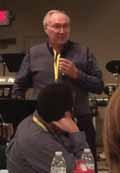
Rob Clogg, president of Grace Fellowship International, a counseling ministry based in Pigeon Forge, Tenn., spoke on “A Life Worthy of the Calling” in three general sessions. –CL
PDC delegates hear from church planters
Delegates and guests of the Pacific District Conference (PDC) convention, held Nov. 6-7, 2015, at College Community Church
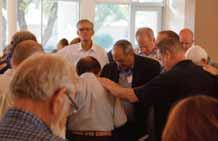
Mennonite Brethren (CCCMB), Clovis, Calif., spent the majority of the time hearing stories from PDC church planters as well as messages from three keynote speakers highlighting each of the PDC objectives: church health, church planting and leadership development. Throughout the convention, church planters from nine fledgling congregations shared personal stories and examples of the creative ways in which these new congregations are connecting with those who don’t yet know Christ Jesus. Church planting was also the focus of the Friday evening program that featured church planter Joe White of Neighborhood Church, Fresno, Calif., as the keynote speaker.
Church health and leadership development were highlighted by speakers Dennis Fast, pastor of Reedley (Calif.) MB Church, who spoke on church health, and Terry Brensinger, president of Fresno Pacific Biblical Seminary, who addressed leadership development.
During business sessions, PDC delegates welcomed The Vine Bible Church of Bakersfield, Calif. and Iglesia Crisitana Fe y Compasion, Inc. of Los Angeles, Calif., as new member congregations. Delegates also approved a spending budget of $513,400 for the 2015-16 fiscal year and accepted proposed clarifications and updates to the PDC by-laws.—CL
Giving Tuesday raises funds for church planting
Nearly 80 donors from across the country gave a total of $39,655 to Mission USA on Dec. 1, 2015, during USMB’s one-day Giving Tuesday campaign. The funds include $20,000 in matching gifts and will go directly to new church plants in 2016. While Giving Tuesday donations fell short of the goal of $60,000, Don Morris, Mission USA director, thanks those who gave. “Your donations really did help as we plant churches together,” he says. “It really is a partnership.” Morris hopes to identify more potential church planters and begin the process of planting at least four Mennonite Brethren churches this year.—CL
Registration opens in February for national summer events
Registration for the 2016 USMB National Biennial Gathering will open in February. Online registration will be live Feb. 1, and registration brochures will be mailed to church offices in February. The two-event gathering will be held July 27-30 in northwest Denver, Colo., beginning with the National Pastors’ Conference, followed by the USMB National Convention. Registration materials will include reservation information for The Westin Westminster, where all activities will be held. The theme for both events will be Press On. Registration for the National Convention is open to all who attend a USMB congregation. Registration for the Pastors’ Conference is open to USMB pastoral staff and their families. Visit www.usmb.org for more information and online registration. To register by phone call 800-257-0515.
USMB


byTheNumbers
Martin Luther King Jr. Day is a federal holiday observed on the 3rd Monday in January.
1986 Year first observed 2000 First year all 50 states officially observed MLK Day 900 Streets named after King in 42 US states and Puerto Rico
U.S. Consumer Product Safety Commission, 2013
5 minutes with...

Tim Neufeld
When a public radio station from Germanycalledto interview him last August,Tim Neufeld knew that his little experiment as a fan of the Irish rock band U2 had become something bigger than hecouldpossiblyhaveimagined.Neufeld,amemberofNorth Fresno(Calif.)Church,turnedoffhisiPhonecameralong enough to tell the Christian Leader about his growing role with aninternationalcommunityofU2fans.


Why are you a fan of U2?
U2 is a band of musicians who are Chris ans and who stand for values similar to those of Anabap sts. They use music to speak about racism, violence, poverty and jus ce in the mainstream culture in ways they probably couldn’t if they iden fied themselves as a Chris an band.
“Periscope” is the iPhone app that launched your fandom to a new level. How does it work?
It’s a live streaming video program—just me si ng at home with the iPhone on my tripod talking to anyone who signs in. There’s a chat feature going on constantly where people are typing their comments—almost like a radio callin show. By now I have about 1,500 people from all over the world following my broadcasts.
How did you get started?
It was one of those organic things that happened by accident. My family and I were driving home from a U2 concert in San Jose (Calif.) when I loaded this new app, turned it on and asked if anyone out there on the web wanted to talk about the concert. Suddenly I had several hundred people listening.
Why have you continued your broadcasts?

I see a dynamic hunger in the culture for the values of the kingdom of God. Many fans write me with ques ons of a spiritual nature—some relate to U2’s underlying biblical themes, some ask for prayer. It’s a wonderful virtual community that I, at least in part, have come to shepherd.
Follow Neufeld on Twi er and Periscope at @ mneufeld or go to www. mneufeld.blogs.com/u2. Watch for his book about U2 scheduled for publica on in Fall 2016.
Interview by Kathy Heinrichs Wiest
Leadership Board talks about USMB future
The future of U.S. Mennonite Brethren ministries was the primary topic of conversation when the USMB Leadership Board met Oct. 12-14 in Wichita, Kan. The Leadership Board has identified three priorities around which it will align national resources and efforts: local, national and global church multiplication, intentional disciple making and developing leaders. Because the document reviewed by the Leadership Board in October is part of a “work in progress,” Leadership Board chair Steve Schroeder says the document remains confidential. The next step in this process is assigned to the five USMB district ministers, Don Morris, interim USMB executive director, and Jon Wiebe, president and CEO of MB Foundation. –CL
Canadian MBs discuss sexuality
The Canadian Conference of MB Churches (CCMBC) study conference “God, Sex and Church: A Theology of Healthy Sexuality,” held Oct. 21–23, 2015, in Winnipeg, Man., focused on pastoral implications, following the more theory-driven 2013 study conference, “Honoring God with the Body: A Study on Human Sexuality.” Interactions underscored the role of relationship as speakers repeatedly deferred answers to specific scenarios.
During the CCMBC Annual General Meeting that preceded the study conference, a breakout session unpacked a CCMBC communications survey, in which respondents strongly affirmed the MB Herald, the CCMBC publication, but asked CCMBC to communicate in a broader range of media. Another breakout explored ways that the church planting efforts of CCMBC, USMB and MB Mission could work more closely together. —MB Herald
World Fellowship Sunday materials available
U.S. Mennonite Brethren are invited to join Anabaptists across the globe Jan. 24 to celebrate World Fellowship Sunday. Each year, Anabaptist-related churches around the world are encouraged to worship around a common theme on a Sunday close to Jan. 21, that date in 1525 on which the first Anabaptist baptism took place in Zurich, Switzerland. Mennonite World Conference (MWC) is providing resources that mirror the theme of the Global Assembly held last summer in Pennsylvania: Walking with God. For more, visit www.mwc-cmm.org. MWC is a global fellowship of Anabaptist-related churches.—MWC
Budding mission leaders gather
Some 35 potential mission leaders age 19 to 45 attended a gathering Oct. 8-11 hosted by MB Mission, the North American mission agency. The event, part of what MB Mission is calling the 2020 Movement, involved speakers, music, listening prayer, intercession and group discussions. The goal was to bring apostolic leaders into local, national and global missions. The vision of the 2020 Movement is to resource and release 20 leaders into local, national and global missions by 2020. —MB Mission
Leaders call for compassion
After meeting together Oct. 23-25, 2015, in Buhl, France, European Mennonite leaders released a statement sharing their concerns about the refugee situation in Europe. Walter Jakobeit, representing the Conference of MB Churches in Germany (AMBD), Jose Arrais, representing the Association of the Mennonite Brethren of Portugal (AIMP), and David Wiebe, executive director of the International Community of Mennonite Brethren, were among the 21 signees. “In these people, fleeing now, we recognize the vulnerable face of God himself,” says the statement, posted on the CL website. The leaders “appeal to the compassion in all people of Europe” to “really look at each other. Take care of each other. Listen to each other.” —MWC
IN THE

The Bible teaches that genuine faith requires knowing, trusting, doing
hen I was a young boy, my family had a picnic one day at Papago Park in the greater Phoenix area. It was a fairly easy climb to get to the “Hole in the Rock” formation, but it was a bit more of a challenge for a boy of nine to climb further up on top of the massive mound. Nevertheless, I joined the line of people walking carefully along a ledge that led to the top.
About halfway there I got stuck. I pressed myself against the rock, my feet on the narrow path, but I was afraid to go either forward or backward. So I took a peek over my shoulder at the 50-foot drop that seemed to be my destiny. As I did so, my young life actually flashed before my eyes, like an old slide show of still pictures— me and my cousins, me and my family, me and my dog. I knew I was going to die.
Just then, a man I had never met, coming in line behind me and seeing my predicament, asked if I needed help. I certainly did! But could I trust him? I didn’t know much about him, but I rapidly sized him up. He seemed friendly enough and strong enough. Then he made a proposal that let me know he was wise enough.
“Here,” he said, “let me put my hand on your back. I’ll hold you up while you keep going.” I placed my faith in this man, cooperated with his instructions, and it worked! I then easily scampered to the top of the rock and lived to tell the tale.
Everyday faith
The word faith is one of those religious-sounding terms that most of us partly understand. We know that it has something to do with confidence in or commitment to someone or something. When we stop to think about it,
By Douglas B. Miller
we realize that we are exercising faith in small ways on a regular basis.
As in my rock climbing, we place confidence in something or someone even though there is no way we can be completely sure what the result will be. For example, when someone orders an item on the Internet, she has faith that the company will actually send the item and that the shipment service hired to deliver it will do so. It is probably impossible to go a single day without exercising faith to some extent. It is a regular part of human living.
So when we talk about faith in a religious dimension we are not talking about something unique or unusual to the human condition. We are simply discussing how this normal experience applies to something of greatest importance. For Christians, that object of greatest importance is the God described in the Bible as the Creator of the universe. It is also applied to God’s Son, Jesus Christ, the Messiah, who came to earth and called people to join God’s kingdom. We are saved as we place faith in him. We also live each day by faith as his disciples.
Three faith dimensions
I was greatly helped a few years ago when I realized that faith, even our everyday experience, has three aspects, and that each of these is addressed in the Bible. First, there is an important belief dimension to faith. We need to know something about the object of our faith whether the object is a human being, like the man who helped me on the trail, or a piece of machinery, such as a lawn mower.
This dimension is prominent in the following event recorded in Mark 8: “Jesus and his disciples went on to
For Christianity, this dimension takes the form of a relationship of trust and confidence in a personal God who saves through Jesus Christ.
the villages around Caesarea Philippi. On the way he asked them, ‘Who do people say I am?’ They replied, ‘Some say John the Baptist; others say Elijah; and still others, one of the prophets.’ ‘But what about you?’ he asked. ‘Who do you say I am?’ Peter answered, ‘You are the Messiah’” (Mark 8:27-29).
Second, there is an important trust dimension to the Christian faith that concerns the motive for what a person does. If I need a rope to go mountain climbing, I risk my health and my very life in the trust I place in that equipment. On the other hand, if my motive for doing something is really to impress people or to earn money, what appears to be trust in a certain person or object may not be genuine.
For Christianity, this dimension takes the form of a relationship of trust and confidence in a personal God who saves through Jesus Christ. Because God is faithful, we confidently reject other forms of security, such as other saviors and even our own work. It is the redemptive work of Christ that saves us: “For it is by grace you have been saved, through faith—and this is not from yourselves, it is the gift of God—not by works, so that no one can boast” (Eph. 2:8-9).
Finally, faith involves performance or doing. If a doctor prescribes medicine for my illness, my faith in the doctor is expressed by actually taking what he or she has prescribed.
Similarly, the will of God must be done by loving God and loving one’s neighbor as oneself (Matt. 22:37-39). God is in the process of creating new people who can live this way. The verse that follows Ephesians 2:8-9 (quoted above) about being saved by grace reads, “For we are God’s handiwork, created in Christ Jesus to do good works, which God prepared in advance for us to do.”
The Apostle Paul understood that faith acts itself out. That is why his great letter to the Roman Christians—in which faith and God’s grace are so strongly emphasized—begins and concludes with references to the “obedience of faith” (Rom. 1:5; 16:26 NRSV, ESV; see also 15:18). The faith is in the doing, not somehow separate from it. This is why Jesus insisted: “Not everyone who says to me, ‘Lord, Lord,’ will enter the kingdom of heaven, but only the one who does the will of my Father who is in heaven” (Matt. 7:21).
Faith distortions
All three of these aspects—knowing, trusting and doing—are inseparable parts of genuine faith. When one or more of these aspects falters, faith becomes distorted. That is why we find the Bible talking about faith problems in at least five ways. For example, when we are trusting and acting but don’t know why, we can become addicted to work (Eccl. 4:7-8; Matt. 11:28; Mark 6:31). Another distortion happens when we fail to trust God for our salvation and attempt to earn it by the things we do. This involves a failure to recognize the extent of our sinfulness and the futility of such effort (Rom. 3:21-31; Heb. 9:14-15).
When we fail to think adequately about our faith we can operate primarily on feelings of trust and become vulnerable to false ideas and practices (Eph. 4:14; 1 John 2:22-23). Another problem is sometimes called “cheap grace.” This happens when we have a strong mental grasp of who Jesus is but lack a sense of accountability to God for living out the mission to which we are called. We can also miss the transformation of our character that God is trying to do in us (Rom. 12:1-2; Matt. 23:2-3; James 2:19).
Finally, we can overemphasize knowledge and minimize both trust and action, playing an often prideful and contentious intellectual game (1 Cor. 3:18-20; 1 Tim. 6:20-21; 1 John 3:18). All of these are distortions of true and healthy faith.
A faith check
It is good to reflect occasionally on the health of our faith, to see how all three dimensions are doing. Here are some possible questions to ask:
Growth in understanding: How much do I know with confidence about the nature and character of God? Am I taking opportunities to learn by studying the Bible?
Trust: Do I balk at taking risks with the things I know God wants me to do? Also, am I doing any of the right things for the wrong reasons?
Action: Am I actually doing the things I’m called to do? What external evidence is there of my commitment to faith in Christ?
The movie The Walk (Tristar Pictures, 2015) depicts the amazing feat (and feet!) of Philippe Petit who, in 1974, walked back and forth several times on a cable stretched between the tops of the Twin Towers of the World Trade Center in New York City. A hundred years earlier, another Frenchman, Charles Blondin, crossed the Niagara Gorge on a tightrope some 1,100 feet in length. By one account, Blondin made 21 crossings on that rope stretched from Prospect Park in the United States to the Canadian side of Niagara Falls. On August 17, 1859, Blondin actually carried his manager across the gorge on his back.
As the story goes, one day after he had made such a crossing, Blondin asked the crowd, “Who believes that I can push a man in a wheelbarrow across this gorge?” Everyone cheered enthusiastically. “Now,” he asked, “who will get into the wheelbarrow?”
Faith in Jesus has similarities to Blondin’s challenge. It means understanding Jesus well enough to trust him by getting into the wheelbarrow. Another way to consider the challenge of faith can be framed like this: Are you willing to allow Jesus to teach you how to walk such a tightrope?
Doug Miller is professor of biblical and religious studies at Tabor College, the Mennonite Brethren school headquartered in Hillsboro, Kan. This article is adapted from an essay published in the Spring 2015 issue of Direction, a journal supported by the Mennonite Brethren higher education institutions in Canada and the United States.
By Conrad Stoesz






Why the past shapes our mission and our future
What is your mission? The idea of a mission statement is common, not only in the church but in general society. Businesses spend good money hiring consultants to help define their philosophy, purpose and goals.
As Christians, our mission is ultimately God’s mission. God calls us to use our specific aptitudes, skills, insights, gifts, character and wisdom for kingdom purposes. At the core of our participation in God’s mission is our identity as his people. In turn, that identity is shaped by our past and our collective memory.
Imagine a people with amnesia. They wouldn’t know what to do or where to go, because they wouldn’t know who they are. Without memories, we have no basis for understanding the present and no vision for the future—no process with which to make choices or actions.
Remembering is celebrating God’s faithfulness
On an institutional level, the past shapes our understanding, our identity—which points us toward action—and ultimately our mission. In the Bible, God admonishes us to remember his presence in the past, in the present and in the promised future.
Writer Paul Woodburn points out that part of worship is the act of remembering. “Communities that forget to remember spend an awful lot of time whining, complaining and filled with fear,” he writes.
The writer of the letter to the Hebrews encourages his readers to remain strong in the midst of suffering and persecution. In chapter 11’s “faith hall of fame,” the mere mention of names like Abraham, Jacob, David, Rahab and Samuel evokes vivid stories of faithful action in adversity. The hearers knew these stories because they had been told for generations.
The author then transitions to present application: “Therefore, since we are surrounded by such a great cloud of witnesses…let us run with perseverance the race marked out for us, fixing our eyes on Jesus.... He endured the cross, scorning its shame...so that you will not grow weary and lose heart” (12:1-3).
In the Anabaptist tradition, the Martyrs Mirror had a similar effect. This 1,295 page book, first published in 1660, is filled with stories of men and women, most of whom were Anabaptists, who suffered and died for their devotion to Jesus and his example of love and forgiveness even in difficult circumstances.
Church anniversaries are natural occasions to look at the past to remember and celebrate God’s faithfulness as seen through the congregation and the lives that made the group what it is today. During these events, people newer to the congregation can get a better sense of the culture and workings of their church family. Recording the formation stories of the church accomplishes a directive found in Psalm 102:18: “Let
this be recorded for future generations, so that a people not yet born will praise the Lord” (NLT).
Memories tell us who we are
As humans, our skills and wisdom are developed through key events in our life and our congregation’s life. We aren’t stuck in the past, but what and how we remember does shape our identity, our understanding of reality and our mission. Our personal and corporate identities are “anchored in a strong historical sense that comes from the ability to experience continuity. Surely if you have nothing to look backward to, and with pride, you have nothing to look forward to with hope,” states historian Barbara L. Craig. Our libraries, archives, study centers and their staff are vital to providing continuity of memory.
In December 2004, on the way back from a family gathering, I began to hear about the tsunami in Southeast Asia. The earth shook, water moved and then came roaring back, devastating homes, businesses and lives. Hundreds of thousands of people lost their lives. As reporters were sent out to cover the story of death and destruction, one was different. It was a story from the Island of Simeulue, Indonesia, which was the first place to have the massive 33-foot waves smack and race beyond the shoreline.
Reporters arrived expecting to find signficant death and destruction. But in a population of 75,000 only seven people died. Why only seven when thousands died in other places? For generations the people of Simeulue have been telling the story of the tsunami of 1907, when the earth shook, the water moved out and rolled back, killing many people. They have been telling their children and grandchildren to head to higher ground when the earth shakes and the water moves out. In 2004, they remembered.
Do you remember October 2, 2006? That was the day Charles Roberts entered an Amish school in Nickel Mines, Pa., with evil intentions. Ordering all the boys to leave, he bound the hands of the girls behind their backs and shot 10, killing five, then turned the gun on himself. Instead of the expected hate and revenge, friendship, money and food—mercy and forgiveness embodied— flowed from the Amish community toward the Roberts family. Half the people at Roberts’ funeral were Amish. That violence happened was not unique; it was the Amish response that garnered attention. Within one week, 1,200 news stories around the world covered the event—with forgiveness at the center of the account. People wondered: How could the Amish forgive so soon? There are many answers, but one woman’s re-
sponse was striking: They forgave because every Sunday, the Reformation-era martyrs whose faithful witness is recorded in the Martyrs Mirror are remembered in Amish worship services. The stories of these men and women, who responded to hate and violence with forgiveness, dwell within today’s Amish, who draw on this memory of their spiritual ancestors to shape everyday life. The Amish community’s history so shaped their identity that they could act in a specific way—offering forgiveness. The past informed their actions and helped them move forward.
When life shakes your world, what stories do you hang on to? What stories will guide your children and grandchildren? Will we turn to Scripture, God’s work in our lives, in our community?
Drawing on the full story
While Mennonite Brethren have put energy into retelling personal and congregational histories and learning from them, God’s story among us is much older. Some MB congregations in the United States and Canada are 50, 80 and even more than 100 years old. But there’s a much longer history of God’s shaping presence in the world, taking us back to the formation of the MB church in 1860, the rediscovery of adult baptism (1525) and other renewal movements.
Even as God’s action in the world is ongoing, some are increasingly hostile to Christianity. In this context, what has God prepared for the U.S. MB Conference, for your congregation, for you?
“Non-Christians associate Christianity with power, violence, nationalistic agendas and scandal,” writes Kurt Willems in an article published in the December 2011 issue of Christian Leader. “But we Anabaptists have a better story to tell.” Have we done enough learning from our Mennonite roots to tell this story effectively?
Study centers, new publications and recognition by other Christian denominations all point to a new interest in the Mennonite-Anabaptist understanding of what it means to be a follower of Jesus. MB roots are deep in the Mennonite experience. As a large cohort of Mennonite Brethren are moving into retirement homes, now is the time to invest in our libraries and archives, our memory institutions. Now is the time to learn more from our past, allowing it to increasingly become part of our identity and to influence our mission.
Conrad Stoesz is the archivist at the Center for MB Studies in Winnipeg, Man. This article is adapted from an earlier version published in January 2012 by the MB Herald, the Canadian Conference of MB Churches magazine.

Is digital adultery poisoning your marriage?
By Forest Benedict
Both God and pornography grabbed my attention at a young age. At age six, my father introduced me to Jesus and at 12 a classmate presented me with pornography. For years these two loves would compete as I sought to serve God while secretly hiding an insatiable hunger for sexual sin. This conflict continued for over a decade. Years of false starts and self-induced suffering eventually resulted in surrender. I finally sought help.
How God redeemed my story is beyond belief. I am now a Christian therapist who specializes in the treatment of sexual addiction. God continues to use my work and writing to bring hope and help to others.
Maybe you can relate to my story. The odds are that everyone reading this is either experiencing the draw of pornography or knows someone who is. Sadly, the church is steeped in sexual addiction. Though too few are talking about it, many men, women and children are mesmerized by this siren’s song.
Pornography has a stranglehold on the church, with an estimated two-thirds of Christian men and one-third of Christian women viewing it. Adolescents between the ages of 12 and 17 are the largest consumers of pornography, and the estimated av-
erage age of first exposure has dropped down to nine. In shame-driven isolation, too many stay silent.
Harmed relationships
Pornography use harms all areas of life, especially relationships. Most couples come to me in crisis. So often one partner experienced early exposure to pornography and believed the myth that married sex would substitute their sexual sin. In shame, they concealed a secret addiction. This was the first betrayal that would someday surface. Maybe they abstained for a season but, eventually, when the stresses and struggles of life emerged, they often ran back to their comfort of choice: pornography.
When spouses seek a pixilated prostitute, they trade their relationship for wreckage (Prov. 5:4-5). Marriages are harmed in three ways when this happens.
Hindered intimacy: Connection and addiction cannot coexist in a relationship. When one partner uses pornography addictively, it prevents intimacy. The connection that comes from reaching out to their spouse does not occur when they run to pornography to cope with life’s pressures. Time




and attention that could be invested in their relationship is instead spent on sexual sin.
A similar impact on one’s relationship with God can also result. Repeatedly reaching to pornography rather than God’s outstretched arms is the sad story of one who forsakes their “first love” (Rev. 2:4). They must choose between lust and love but cannot have both.
Stifled sexuality: It is baffling to me that pornography was once promoted as a sexual aid. If anything, using pornography stifles sexual satisfaction. Premature ejaculation and erectile dysfunction can be consequences. Not only can pornography use diminish sexual ability, it also alters sexual attitudes. According to Covenant Eyes, a company that offers Internet accountability software, 88 percent of porn scenes contain physical aggression and 49 percent contain verbal aggression. It is no surprise that this skews views of sex. The “blessed” and satisfying sexuality hailed in Proverbs 5 is light-years away from the demeaning distortion of sex present in most pornography.
Unparalleled pain: Even when sexual addiction “only” involves pornography, it is often experienced as infidelity. Many partners who undergo this type of relational trauma experience symptoms of post-traumatic stress disorder (PTSD), losing their sense of safety. These partners can experience anxiety, depression, rage, hyper-vigilance, intrusive thoughts and shame. They may blame themselves, becoming preoccupied with their body image. They may lose trust in their spouse and in God. Sadly, these symptoms often persist long after the day of discovery. Covenant Eyes reports that over half of divorce cases are related to pornography addiction, so it is apparent that pornography use can poison a marriage.
Finding a new path
Pornography use harms more than just marriages. Relationships with children, God and others are impacted. Neurologically, self-control is impaired. Selfimage suffers. Witness to the world is silenced. Justice is undermined, as the porn industry propels sex trafficking forward. No sphere of life is untouched. How fitting that the plea of Proverbs is to keep to a path far from the adulteress (Prov. 5:8).
For the reader who is ready to pursue a new path, here are six crucial strategies for finding freedom:
1. Find same-sex support. Accountability is essential for both prevention and confession. When tempted, humbly call for help. Grace-based, not shame-based, support will sustain lasting change. Both addicts and partners can benefit from a guided group setting where their secrets are safe and their hearts can find healing.
2. Go deep with God. Brennan Manning writes that the journey from mistrust to trust can be like a
“second conversion.” Letting God compassionately hold one’s heart in trying and tempting times is much different than simply memorizing verses. Both may be helpful but recovery will entail daily experiences with God, not just learning about God.
3. Pursue external and internal protection. Easy access to the “portable prostitute” is a trap. Protecting devices with filters and accountability software is often necessary. Implementing internal protection means learning self-care routines that strengthen self-control. Adequate sleep, exercise, and healthy eating will bolster the brain’s resistance to temptation. For those traumatized, self-care is equally essential.
4. Seek out a skilled professional. Stories abound of those who sought support in all the wrong places. Seeking someone who specializes in sexual addiction treatment can prevent unnecessary pain and promote lasting healing. This will be important for both addicts and their spouses.
5. Disclose with discretion. Dumping every detail of a pornography problem on a partner can be detrimental. Honesty and transparency about the past and present are necessary but without the guidance of a trained professional, some specifics may cause unnecessary wounds.
6. Be patient with your partner. Recovery for both addicts and partners is a marathon, not a sprint. Long-term change will require significant soul-work. Patience will provide endurance for the lengthy road ahead.
Hope remains
For both the reader who is far down the path of pornography and the traumatized spouse, there is hope. Our loving Father can “restore the years the locust have eaten” (Joel 2:25). For those who have humbly sought help, I have seen relationships reconditioned to a new level of intimacy. There may be years between the present reality and a healed marriage. Yet, this rough road to recovery is far superior to the instability of a divided heart (James 1:8), the despair of disconnection and the anguish of an unfulfilled life lost to lust.
I believe God is raising up a church that rejects pornography and seeks authentic connection. As God unshackles us, he invites us into his mission of setting captives free. Though this path to healing is steep and treacherous at times, it is incredibly rewarding. And the view from the top is spectacular. It is my steadfast hope that someday I’ll see you there.
Forest Benedict is a graduate of Fresno Pacific Biblical Seminary who currently serves as an adjunct faculty member in marriage and family therapy. He is a licensed marriage and family therapist and certified sexual addiction treatment provider.
Lost and found
Garden City congregation extends love to Lost Boys, new refugees
Akoon Kenyang was only six years old when he fled his home in South Sudan to escape civil war. He was one of some 20,000 “Lost Boys” who embarked on a treacherous journey in the late 1980s and one of about 4,000 who eventually came to the United States as refugees.
Once lost, Kenyang is now found in Christ and has a new home at Garden Valley Church (GVC), Garden City, Kan. He is one of many the church is learning to help as they open their heart to new waves of refugees settling in the Garden City community.
An unthinkable journey
Kenyang’s journey, like that of many refugees, is like something out of a nightmare. He was tending the family’s cattle when shooting started in his village. He and other children began a three-month journey on foot, fleeing Muslim forces from North Sudan across borders to Ethiopia, back into Sudan, then to Kenya. He talks of wondering where his next meal would come from and of not knowing whether his parents were alive.
A childhood that should have been filled with innocence was spent in the Kakuma Refugee Camp. In 2000, he was one of the first Lost Boys brought to the U.S. “We were coming to America to have hope over here,” he says.
He was first placed in Richmond, Va. But when he lost his job there, he went to Amarillo, Texas, then followed the railroad and the advice of friends to Garden City. “I saw a quiet place and nice people,” he says.
Those “nice people” helped him get a job at the Tyson meat packing plant. He found Garden City so agreeable that he spread the word among his friends, who also came to Garden City.
Refugees come to Garden City
Like Kenyang, many refugees these days find their way to Garden City by word of mouth. But many are also coming to the town through more official channels. The U.S. Department of State works with nine agencies to resettle those with refugee status in 190 designated communities. One of those agencies, International Rescue Com-
mittee (IRC), works in Garden City as a branch of their Wichita, Kan., office and brings about 75 refugees from all over the world to the area each year.
IRC volunteer Christine Lightner is part of the GVC congregation. Lightner is thrilled to see the nations coming to her doorstep. It’s an opportunity, she says, for the church not only to obey the biblical command to love foreigners but also to impact the world. “Our reaching out to them is a part of God’s continual work in reaching the nations with his love,” she says.
As an IRC volunteer, Lightner connects needs with resources in the community. And the needs are great. IRC helps refugees in Garden City find housing, but the government check they receive for start-up costs usually falls far short. Often, they arrive with literally nothing but the clothes on their back. They need rice and the kettle in which to cook it, chairs, bedding and clothing.
This is one area where GVC has been able to provide tangible help. The church has set aside a store room in the church to collect donations of furniture, housewares —anything that might be helpful. Lightner says her congregation is eager to help and has been quite willing to donate what they can.
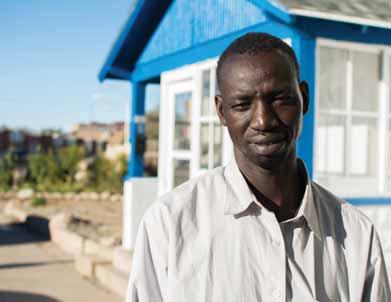
Akoon Kenyang, a 2000 refugee from Sudan, says that the best way to help refugees is to lead them to Scripture.
Chayne Sturgeon
But more than anything, Lightner says, refugees need a friend. “They need a person or people who have time for them—people who have the grace and the patience and the unconditional love to just walk with them.”
Those are the kinds of people who made a difference in Kenyang’s life.
Found
The trauma that refugees experience often leaves deep scars and sometimes leads to poor choices. In Kenyang’s case, his choices landed him in jail. His wife left him, and he lost custody of his three children. When he was released from jail, he had to start over—again. “I was so mad,” he says.
At this low point in his life, an acquaintance advised him to go to church, but he resisted. “Where I come from I don’t believe in God,” Kenyang says.
His friend persisted: “You need to call this guy—his name is Steve. He can help you.”
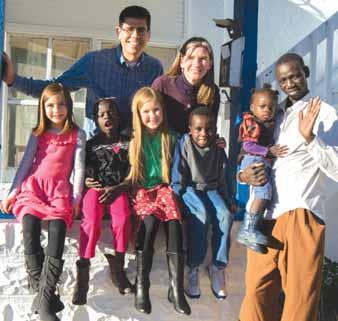
Finally, he called Steve Ensz, pastor of GVC, to ask for a ride to church. Kenyang felt welcomed at GVC, so he kept coming and brought friends.
“Before we knew it, there were three or four Sudanese attending,” Ensz says.
Kenyang’s understanding of the gospel grew as he got to know people from the congregation. People like Lightner’s husband, Jonathan, who still makes an intentional effort to visit with Kenyang and the other Lost Boys. GVC attender Matt McCallister gave Kenyang an audio Bible so that he could listen to Scripture while he worked. When his coworkers teased him about listening to music so often, Kenyang told them, “It’s the Word of God.”
Because of the love the GVC congregation showed him and because of the power of the Word of God, Kenyang made a commitment to Christ. He was baptized at GVC on Easter Sunday 2014.
“I believe in God now,” he says.
After so many years of survival and fear, he is beginning to feel safe in Christ’s love. “Jesus right now is showing me the way,” says Kenyang. “If I believe in God, nothing can happen to me. He can protect me wherever I am going. That’s the best thing in my life, changing me.”
Ensz says that, although Kenyang’s story is far from over, he is making better decisions and working toward a better life. He has regained custody of his children and is learning what it means to be a single parent of three. And Ensz sees a new joy in Kenyang through it all: “I can see a change.”
Who, not what
Kenyang says that the best way to help refugees is to lead them to Scripture, as GVC did for him. “When people are trained by the Word of God so they know the Word of God, that’s what brings comfort.”
Lightner says that often people ask what refugees need, “but the ultimate question is who do they need.” Ultimately, only God can comfort those who are grieving the loss of loved ones far away, and only he can promise justice for atrocities suffered. So she urges Christians to pray that refugees will come to know God and that churches in their communities will show them the love of Christ. “It’s such a lifeline, if we can connect them to Christ.” —Myra Holmes Visit www.usmb.org/Christian-Leader for more about Kenyang and GUC’s work with refugees.
Jonathan and Christine Lighter and their two daughters are among those who have befriended Akoon Kenyang and his three children. The two families often sit near each other during worship at Garden Valley Church and attend community events together.
Chayne Sturgeon
Seminary finds new opportunities
God’s spirit is moving at Fresno Pacific Biblical Seminary
God is up to something here,” says Fresno Pacific Biblical Seminary President Terry Brensinger. Just five years ago MB Biblical Seminary in Fresno, Calif., was struggling for survival for lack of students and diminishing funding. A merger with Fresno Pacific University (FPU) infused new life into the languishing institution and has placed it in an upward trajectory and provided a renewed sense of calling. Brensinger recognizes the renewal as a movement of God’s Spirit.
Enrollment figures are a tangible measure of the institution’s vitality. In an era when many seminaries are seeing declines in their enrollment, Fresno Pacific Biblical Seminary (FPBS) is growing. FPBS admissions director Jeff Zimmerman reports that overall enrollment has grown 30 percent since the merger with FPU. He expects another 25 to 30 new students to enroll in January.
Seminary recruitment has focused strongly on students interested in ministry studies. Whereas the marriage and family therapy program at one time made up half of the student body, now 64 percent of students are enrolled in ministry studies. The Master of Arts in Theology is the seminary’s fastest growing program.
“The growth in our ministry studies that is fueling this shift is very encouraging as our roots are in training pastors for local and global churches,” Zimmerman notes.
The seminary is also positioning itself to meet the growing demand for online study options in pastoral ministries. A new master’s in transformational leadership and ministry degree program, projected to begin its first cohort in Fall 2016, will enroll people currently in ministry roles. Students will be able to log on for classes from anywhere in the world.
The three-year master’s degree program will combine online courses with four one-week intensive study gatherings, two on the seminary campus and two on-site at churches where students can meet pastors and see the principles in practice.
“My own doctoral work was a combination of online and on-campus studies,” explains program director Brian Ross. “It was an incredibly rich time with a cohort of people who are still friends. We are hoping to replicate that kind of experience with groups of students
from all different denominations and traditions.”
While many seminaries have begun online offerings, Ross says the FPBS master’s degree is unique in its practical ministry focus from an Anabaptist theological perspective.
Partnerships are another sign of vitality. Brensinger reports a growing interest among various institutions in establishing networking partnerships with the seminary. “We have to exercise discernment because there are so many opportunities,” he says.
One partnership that particularly animates seminary leadership is with what has been called the neo-Anabaptist movement. Nationally-known church leaders such as Greg Boyd and Brian Zahnd are among those who, although they did not come from the historic Anabaptist denominations, have found themselves drawn toward an Anabaptist understanding of the church and its mission.
“Some of our own heritage has become a significant theme or theology across denominations,” Brensinger explains. “People in all traditions are recognizing things we have held dear for long time.”
The seminary is working on partnerships that will tap into the insight and experience of Boyd, Zahnd and others who pastor some of the largest Anabaptist-oriented churches, both denominational and independent, in the United States and Canada. The seminary’s online program will involve these leaders in the online classes and use their churches as laboratories for the weeklong face-to-face sessions.
In addition to these national and international connections, FPBS also has a number of local and regional partnerships. The seminary’s on-site counseling pro-
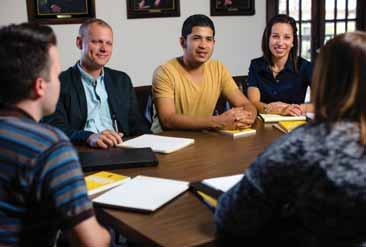
Brian Ross, assistant professor of pastoral ministries, far left, joined the seminary faculty in 2014 and is among the 21 faculty members teaching at Fresno Pacific Biblical Seminary. Currently, 64 percent of the student body is enrolled in ministry studies. FPU
gram has contracts providing counseling services to most of the school districts in the area, including the large Fresno Unified School District. “It has grown dramatically,” says Brensinger, “to the point where we have over 50 counselors working on-site in local schools.”
An opportunity for the seminary to serve hospitals in the community will result from a new partnership with Clinical Pastoral Education (CPE). As the United States’ premier chaplaincy training program, CPE offers academic credit required for licensed chaplains. The program’s Central California chapter has been affiliated with Stanford Hospital and serves most of the major hospitals in Central California. Soon the chapter’s director will become part of the seminary staff.
The seminary’s Center for Community Transformation has become a networking hub, both in Central California and nationwide, for people and agencies interested in urban ministry.
Church and civic groups access the center’s resources, and the center is actively engaged with local ministerial efforts to bring renewal to the city of Fresno.
The seminary has also tapped into a growing pool of potential students looking for practical ministry training from an Anabaptist perspective. “Anabaptism has a lot to offer younger adults who want to clearly follow Jesus in the Scripture but in ways that are not too wed to American values,” Ross says.
Some of these students come from the historic peace churches, but many are neo-Anabaptists who are looking for a holistic approach to ministry. “Anabaptists are often pegged as social radicals who don’t care about evangelism and church planting,” says Brensinger. “We see social justice and evangelism as two sides of the
same coin, an embracing evangelical spirit that cares about the whole person.” This, Brensinger says, is what a new generation of students is looking for.
The transition from an independent institution to being a school of FPU has required a new governance structure for the seminary. For the last year and a half, a diverse group of leaders from Mennonite Brethren as well as other faith communities have served as the FPU board’s seminary committee. Church leaders, business people, academics and nonprofit leaders drawn locally as well as across the U.S. and Canada form a group whose ideas, Brensinger says, “have already made a major difference in the life and ministry of the seminary.”
Among the priorities they have identified is strengthening the seminary’s function as a resource for the church. In designing the new online degree, for example, the seminary used focus groups to tap into the insights of 150 church leaders, pastors and alumni locally and nationally. “We’re working hard at not just creating what we think we should offer, but what the churches are actually asking for,” says Ross.
In further efforts to resource churches, plans are underway through the seminary’s Anabaptist Center to offer pastors accessible opportunities for continuing education and renewal experiences. Other resources for congregations “will speak to questions that people in the pews are asking,” adds Brensinger.
The positive responses from students, pastors and various networking partners have energized the seminary that completed a new five-year strategic plan last summer. “We spent over a year in a wonderful process of discerning our mission and we’re already halfway through phase one of the strategic plan,” Brensinger says. “Something fresh is taking place, bigger than any of us could have imagined.” — Kathy Heinrichs Wiest

Perspectives of Global Mennonite Brethren on Mission in the 21st Century
Order your copy today! www.kindredproductions.com • 1-800-545-7322



Kindred Productions
“It’s kind of a B-12 shot”
CDC renewal fund aims to energize churches for effective ministry
Anyone who has ever set and broken a New Year’s resolution knows that firm resolve isn’t enough to bring needed change. Sometimes, a move toward greater health requires a little help from outside.
That’s true for churches, too.
So the Central District Conference (CDC) has established a new fund to lend support to those churches that need an extra boost to propel them to more effective ministry.
“It’s kind of a B-12 shot—some energy to bust through,” says CDC district minister Rick Eshbaugh. “There are churches that are plateaued, that are going through significant issues and would possibly be helped by being able to access additional funds to help them through that cycle.”
The money for the Church Renewal Fund comes from the Katy Glanzer estate, a $1.2 million gift. The district earmarked $70,000 of that endowment for church renewal and leadership development, under the supervision of the CDC Church Planting and Renewal Committee, at their 2014 annual convention.
Eshbaugh says the fund is intended to mirror the district’s model for church planting, in which funding is coupled with relational support from a project team. “It’s not just a matter of sending in money.”
A restart for Faith Bible Church
The first church to receive support from this renewal fund is Faith Bible Church (FBC), Omaha, Neb. FBC has been serving faithfully in their Omaha neighborhood for about 45 years and, much like a middle-aged person, the congregation was beginning to notice some wear and tear.
They had been without a lead pastor for a long time, although a preaching pastor provided Sunday sermons. Attendance hovered around 35. The church building was in need of repair, but weekly offerings were too small to take care of maintenance, much less support a full-time pastor. Perhaps most importantly, the congregation lacked unity and vision.
According to Stephen Stout, who has attended FBC for 24 years, “We didn’t have a lot of momentum or a lot of energy to go forward.”
When the preaching pastor announced that it was time for him to move on, FBC knew it would take more than firm resolve to get back in shape. They even considered closing the church.
Enter the 2015 CDC renewal fund grant along with a project team: district minister Eshbaugh; John Langer, chair of the Church Planting and Renewal Committee; and committee members Chad Stoner, pastor of Stony Brook Church, Omaha; and Daniel Rodriguez, pastor of Iglesia Agua Viva in Omaha.

Restart provides unity, vision
With the support of this CDC church renewal project team, FBC decided to pursue a restart. Often a restart means closing the church and beginning with a fresh identity and vision. FBC chose instead a soft restart, remaining open and retaining the name, but rethinking their mission. If a restart is like razing the house to build a new one, FBC’s soft restart is more like remodeling the house while still living there.
Andrew Petts, a Grace University student from Salem MB Church in Bridgewater, SD, has become very involved at Faith Bible Church. Petts, pictured here painting the church's new vision statement on a wall in the sanctuary, has a passion for technology and has helped the church make upgrades to their sound system.
One of the first steps was calling Stout as the intentional interim pastor. Stout also serves as director of Good Neighbor Ministries, a community nonprofit that works to meet practical needs while sharing the gospel.
In March 2015, the congregation took a good, hard look at where they’d been and where they wanted to go. “Sometimes you have to look at a wound before you can heal it,” says Rick Reck, FBC elder. It wasn’t without pain: They worked through conflict and lost well-loved members.
But FBC came through the process with new unity and vision. “We’ve determined to become more of an evangelistic outreach church rather than sitting in our pews on Sunday,” Reck says.
Much of the renewal funding for FBC went toward facility improvements. While the district funds aren’t intended primarily for brick and mortar, in this case, the church needed to attend to delayed maintenance issues to increase their presence in the neighborhood. They have also hired a part-time, temporary assistant to lend a hand to Stout and to build a new website for the church.
In just about a year, FBC has become a much different church. Attendance averages 60, including 10 new members. A streamlined leadership structure will allow the church to pursue ministry more effectively.
The congregation has appreciated Stout’s pastoral leadership and will vote this month on a proposal that Stout serve as the full-time pastor. New leaders are in place for worship, children’s ministry and men’s ministry. Offerings, though still small, have increased noticeably. Small groups have restarted. There’s a new spirit of love and harmony.
Stout is quick to point out that FBC has only begun in this new direction. “Most of the work is still in front of us,” he says. But he’s also convinced that their story is far from over, and the support of the CDC has made a tangible difference. “Just knowing that CDC was behind us was very encouraging,” says Stout. “We’re not alone in this.”
Leadership development at Iglesia Agua Viva
Iglesia Agua Viva (IAV), also in Omaha, will be receiving support from the CDC Church Re-
newal Fund in 2016. The support for this Spanishlanguage congregation will look much different than the support for FBC, since it will go toward schooling for the pastor and leadership development.
Daniel Rodriguez, IAV pastor, says that most of the congregation’s Hispanic attendees have little Christian background. While the church works hard to equip leaders, more training will help Sunday school teachers, youth leaders, those who preach on Sundays and others go to the next level.
Rodriguez says, “Everywhere in the church we feel that it is really important for us to have servants of God who have a heart to serve God but also are prepared to do their best to serve others.”
Thirteen adults from the congregation will be taking courses to further their training. The district funding will assist with books and some necessary travel expenses.
Secondly, the fund will enable Rodriguez to get further schooling. He has pastored IAV for six years while working part-time. “God has done amazing things in my family life and the church, but one of the things that I always wanted was to get more education to serve better in the ministry,” he says. The district funds will supplement the salary Rodriguez receives from the church so that he can quit his part-time job and pursue a bachelor’s degree in pastoral ministries at Grace University in Omaha.
CDC minister Eshbaugh says that it is important to focus on health for congregations like FBC and IAV because local churches are on the front lines of ministry. “We have an opportunity to do missions through our existing churches.”—Myra Holmes
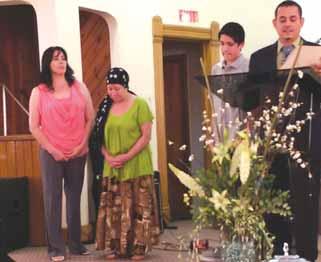
Pastor Daniel Rodriguez says that CDC assistance to train church leaders at Iglesia Aglea Viva will help this Spanish-language church reach Hispanic people in Omaha.
Iglesia Agua Viva





Don Morris Mission USA director

Responding to hate with good news
The power of the Gospel can sweep away evil in our world
ISIS, radical Islam, beheadings, terrorism, shootings, rampages, nuclear war threats, suicide bombers, genocide, Christian martyrs, Jews versus Palestinians, cop killings, revenge killings, gang warfare, death to America, flag burnings, degrading Sharia law mandates—the list could go on. There is so much violence and hatred in the world. It’s enough to make one want to run and hide in the hills.
Our world is in chaos. Atrocities that used to be isolated occurrences are now commonplace. Sometimes I feel like I’m regularly exposed to so much evil that I hardly even respond to it all anymore. I’m almost numb to hearing about the worst that people can do to other people. I don’t like the fact that hearing about Christians being murdered by the hundreds in the Middle East makes me sad but doesn’t necessarily elicit deep-down personal grieving. It should. What’s happening in much of the world these days is truly horrific.
These events are driven by one common thing: human sin. Paul says in Galatians 5:20 that some results of sin are “idolatry and witchcraft; hatred, discord, jealousy, fits of rage, selfish ambition, dissensions, factions.” It seems to me that our world is immersed in a fit of rage, dissention and discord.
You and I haven’t personally been exposed to the kind of persecution that much of the church around the world has endured. We didn’t wake up one day and discover that in order to survive for
The #1 church trend of 2015 that is expected to continue:
another day we must flee our homes, jobs and families. I also know, however, that persecution is a part of the deal when one declares, “Jesus is Lord.” In fact, I’m reminded quite often that Jesus said, “If they persecuted me, they will persecute you also.” In all likelihood, as we look to the future, we can expect persecution of Christians to increase, perhaps even here in America.
I’m writing about this because I believe we have a unique historical opportunity to be part of spreading the gospel in the midst of incredible violence, hatred and persecution. I believe without a shadow of a doubt that we have entered a time in history when the power of the gospel will sweep across the planet in great movements of evangelism. It’s already happening in many places in the world. In droves, people are hearing about Jesus and responding.
Whether or not this also happens in North America is yet to be seen. There are many indications that God is indeed up to something amazingly incredible. I’m not alone in saying that the demonstration of the power of God is increasing right here in America. I believe we have a window of witnessing God’s blessing over the coming years—prior to Jesus coming with the clouds. (Rev. 1:7) We must do all we can to bring the good news to people all across the U.S.—while there is still time!
smaller worship gatherings
The era of the large worship gathering is waning. Churches that are growing will likely do so through multiple services, venues and sites. This trend will accelerate through the growing influence of Gen X and the Millennials.
Source: Thom Rainer, ThomRainer.com 2015
Fresno church plant begins services
Goals for 2016 include addressing neighborhood needs
Church planter Joe White anticipates great things for Neighborhood Church in 2016. The church plant in the Jackson Neighborhood of Fresno, Calif., will launch weekly Sunday gatherings Jan. 24. White also expects to start a nonprofit to address specific needs in the community and open a small business to employ neighbors with barriers to employment.
Neighborhood Church, a church plant partnership between Mission USA and the Pacific District Conference, held three Sunday morning “preview services” to offer neighbors a chance to check out the new church. More than 100 people packed into the small neighborhood elementary school cafeteria where Neighborhood Church is meeting for the preview services.
“Our goal is to grow to 120 people—our cafeteria capacity—and to send a group of people from Neighborhood Church to plant another church in a different part of our neighborhood to reach more neighbors with the good news of Jesus,” says White.
White describes this fledgling congregation as “a neighborhood-focused and neighborhood-impacting church plant.” The church plant is focusing on 923 homes in an eight-street by 12-block area, which represents 3,500 people.
“Jackson is an incredibly vulnerable neighborhood with large income inequality,” says White. “Seventy-one percent of our neighborhood is without a high school education and has an average income of $26,000 annually, well below Fresno’s median income.”
White and his wife, Heidi, and their children moved to the Jackson Neighborhood in February 2015. Since then,
White reports that 22 kids in the neighborhood have indicated their desire to follow Jesus.
During their first year in the Jackson Neighborhood, Neighborhood Church volunteers have served in multiple classes at Jackson Elementary School helping kids with math and reading and hosting an after-school evangelistic club attended by an average of 41 kids as well as an afterschool club for 15 neighborhood teenagers each week in a local apartment complex.
Volunteers have organized a Saturday biweekly sports ministry that serves 50 kids and their parents. They have also renovated a formerly abandoned 100-year-old workshop and turned it into an artisan space where youth in the neighborhood can learn job-transferable skills like woodworking and welding.
White asks for prayers that he and his wife will find new energy as they begin their second year of ministry in the Jackson Neighborhood.
“Heidi and I have personally met over 150 neighbors in our neighborhood in 10 months and have hosted many for dinners and barbeques,” writes White in an email. “We have also had two interns who are learning about urban ministry living with us, which in addition to our four young kids, including a baby born in mid-December, has made us very tired. Please pray for rest and renewal (Psalm 23) as we launch into 2016.”
While they are fatigued, the Whites are also finding joy in their work. White cites efforts to create places for their neighbors to gather as one thing that has brought the couple happiness.

“We have transformed our large front and side yard into a community garden which includes a prayer labyrinth, 100 varieties of edible and drought-resistant landscaping, an outdoor barbeque pit where neighbors can gather and eat together, an outdoor stage for neighborhood concerts and four stations that are placed along a winding path allowing us to tell neighbors about the story of the universe—creation, fall, redemption, restoration,” says White. “In our urban environment, we have loved to consider how to take private property and turn it into public property, green spaces—the connective tissue of our neighborhood.”
—Mission USA news story
Church planter Joe White, right, shares during a Neighborhood Church "preview service."

Resolve to resolve
Four reasons resolutions matter even when you break them
When it comes to New Year’s resolutions, the seeming inevitability of failure has led many to resolve not to resolve. Here are four reasons it’s worth the effort—even when you make resolutions Dec. 31 and break them by Jan. 2.
Resolutions force us to be honest with ourselves. Jeremiah 17:9 says, “The heart is deceitful above all things and beyond cure.” Most of us are masters of self-deception and blind to our own brokenness. We devise excuses for avoiding change. We have been so profoundly twisted by sin that being straightened is an ongoing process.
A resolution is a declaration that names our brokenness and admits that we need to move further into the life of the resurrection with the help of Jesus. Whether we follow through on that declaration is another issue entirely and an important one, but it doesn’t render the resolution itself worthless. It is a way of calling out our deceitful hearts and moving them toward fidelity.
Making a resolution implies we control our actions. Dodging responsibility for our actions has become an art form. We create ways of eschewing responsibility, fancying ourselves victims of a myriad of forces outside our control. This denies the agency we have been given as creatures made in the image of the all-powerful God. We are not all-powerful, but we are not inept or helpless either. Paul lays this out magnificently in 1 Corinthians 9 when he calls us to run the race in such a way as to win. He urges us to train ourselves for righteousness. His entire argument speaks against the idea that we are unable to change.
When we make a resolution, we are clearly stating we can do something to change. The very act of making resolutions can be a part of our training, making us people who will not always blame others for the state of our lives.
Resolutions mean we’re not giving up. “For I do not do the good I want to do, but the evil I do not want to do—this I keep on doing” (Rom. 7:19). Over the past 20 years I have tried to change a specific area of my life hundreds of times in dozens of ways. I have gone through seasons of intense effort and seasons where I have just given up. The sticky fingers of sin on our souls can be debilitating.
But God has given us a spirit of power, not of fear. The power of the resurrection urges us forward despite our setbacks. A resolution is a statement that we are going to keep trying. The alternative is to give up and accept yourself and everything around you as it is, forever. This is not a Christian option.
Resolutions make us think about the stories our lives are telling. In the midst of everyday life, it is easy to lose any sense of greater purpose. Living our story as a part of God’s great story gives our lives a specific character. This is the picture laid out for us in the Bible and most clearly in the life of Jesus.
When we make resolutions we back up from the details and look at the big picture. We imagine the story we’d like our lives to tell and how our stories point to the one true story. This exercise gives us greater purpose, fulfillment and hope for what can be.
So whether you call them resolutions or not, resolve away this year. Work with God to become fully human, whole and abiding in him. Work with him for the renewal of all things. Walk with the Spirit into the new life offered to us in Christ in this new year.
Trevor Lee is lead pastor at Trailhead Church, Littleton, Colo. This article is adapted from one of his blog posts. Lee blogs at www.trevorslee.com



Kathryn Glanzer
The dechurched
What do we do when people leave the church but not Jesus
They are called the “dones” and the “dechurched.”
They are the people who, after years of being actively committed, walk away from the church but not their Christianity. As I continue to encounter friends and family who have left their churches, I struggle with how to approach the topic with them.
My whole life I have sought to bring people to church, believing that the church provides loving support amongst community. Yet, some of my wise and spiritually astute friends have given up on the church. Because of this choice, they have been made to feel like prodigals or prayer projects, furthering their desire to keep their distance. Yet, these people have not strayed from Jesus. They still serve Jesus and give to their communities. They continue to work toward loving and seeing people the way Jesus would.
It was one of my dechurched friends who told me about Church Refugees, a book that sociologists Josh Packard and Ashleigh Hope published this past summer. It uses social theory to “explain why people are increasingly done with organized religion, what it means for churches across the country and what can be done about it.”
It is based on the results of an 18-month study with over 100 participants, ages 18 to 84, who have left the church. The study, while limited to mainstream American churches, revealed consistent data. The participants are people who were heavily involved with the church before they made an explicit or intentional decision to leave the church, but have not abandoned their faith.
The authors point out common desires among the participants and common reasons for leaving. The dechurched want community, to affect the life of the church, conversation and meaningful engagement
with the world. Instead, they have experienced judgment, bureaucracy, doctrine and moral prescriptions. Several of the participants give testimonies of repeated attempts to work within a church only to be met with roadblocks along the way. In short, they have given up on the church but not on God. They would rather be refugees: displaced from their homes and taking their beliefs and culture with them.
How should the church community respond to these refugees? Hope and Packard note that the methods that were useful in previous decades in drawing people into a community and helping them to stay connected may no longer be relevant. Hope and Packard recommend four strategies for reengaging people in local church life: invite congregants to participate and share ideas, undermine bureaucracy through continually changing committees and church leadership, be truly relational by focusing on doing things with congregants rather than for them and allow the celebrations and struggles of the local community to shape the congregation, thereby impacting that community.
In the end, this book helped me recognize the unspoken desire of church refugees to be connected with community. For my dechurched family and friends, I know that the Holy Spirit can build that desire and match them with a congregation to the benefit of both parties. As a congregant, I know that we can be more inviting by encouraging conversation while speaking truth. In any case, at the core of every one of us is the desire to be genuinely heard by the people we do life with.
Kathyrn Glanzer is the youth minister at Ebenfeld MB Church, Hillsboro, Kan.

Many congregations provide meals for families faced with a variety of circumstances—the birth of a baby, the death of a loved one and prolonged medical treatment or illness. Coordinating meals can be an overwhelming task, and that’s why Adina Bailey and Scott Rogers created www.takethemameal.com. The website allows users to create at no charge a customized online sign-up sheet that makes it easy for friends and family to take meals to those in need.


milestones
BAPTISM/MEMBERSHIP
David and Karen Schoenhals were received Nov. 8 as members of Pine Acres Church, Weatherford, Okla
Baldemar Felix, Mackenzie Toews, Madison Toews, Joel Van Horn, Caleb Wilson and Philip Wilson were baptized Nov. 16 and received as members of Shafter (Calif.) MB Church. Melissa Bergen, Virgil and Karen Reimer and Courtney Van Horn were also received as members.
Avery Unruh was baptized Sept. 20 at Hillsboro (Kan.) MB Church. Bailey Kaufman and Rinda Amstutz were also received as members.
Mario and Michelle Azar were received Oct. 18 as members of Bethesda MB Church, Huron, SD
Krystal Jackson and Shaley Jackson were baptized Nov. 22 and received as members of Kingsburg (Calif.) MB Church. Patti Carnell and Nancy Jones were also received as members.
Brent Senff, Darcie Senff, Kaleb Senff and Tiffany Senff were baptized and received as members of Henderson (Neb.) MB Church Oct. 11. Nicole Mierau and Heidi Schmidt were also received as members.
Chester and Ruby Berg, Mike and Barb Coulson, Arland and Jackie Eastwood and Erica Williams were received as members of First MB Church, Wichita, Kan., Oct. 18.
Cameron Decker, Dixie Beitelspacher, Carson Kirby, Jeff Beitelspacher and Tanner Storer were baptized and received as members Sept. 20 at Grace Bible Church, Gettysburg, SD. Grace Cook and Kerri Hall were also received as members. Michael Vander Vorst was baptized and received as a member Sept. 27.
Jeremy Davidson, Ellen Janzen and Katie Wells were baptized Dec. 6 at Parkview MB Church, Hillsboro, Kan. Cameron Davidson was also received as a member.
David, Jessica and Elizabeth Clingan, Nancy Foiles, Aaron and Joy Thomas and Duane and Cindy Weigel were received Oct. 25 as members of North Oak Community Church, Hays, Kan
CELEBRATIONS
The Rock of Southwest, Littleton, Colo., broke ground Oct. 25 on a new facility at the former site of Belleview Community Church, Littleton, Colo. The Rock and Belleview, a USMB congregation, merged last summer.
WORKERS
Melissa Bergen was hired Nov. 1 as director of local missions for Shafter (Calif.) MB Church and pastor at Iglesia Compañerismo Cristiano,
Shafter. This part-time, dual role is designed to build bridges and relationships between the two congregations.
Malcolm Light has been affirmed as the new lead pastor at Reedley (Calif.) MB Church. He and retiring pastor Dennis Fast will be transitioning over the next months.
John Coker is the new middle school pastor at Discovery Bible Fellowship, Collinsville, Okla
Daniel Clubb retired as pastor of Shorelife Community Church, Capitola, Calif., in October. Trevor Lee, former associate pastor, is serving as lead pastor.
Forrest Jenan has been called as the lead pastor of Neighborhood Church, Visalia, Calif. He began in the new role Nov. 1.
Sean Estes is the new youth pastor at Corn (Okla.) MB Church. He began Nov. 16.
DEATHS
Friesen, Elmer Louis, Reedley, Calif., member of Reedley MB Church, Oct. 5, 1923—Sept. 28, 2015. Parents: John C. and Pauline (Nickel) Friesen. Spouse: Barbara Duerksen, deceased. Children: Timothy, Billy, Rhonda; six grandchildren; four great-grandchildren.
Grunau, LeOra, Hillsboro, Kan., of Hillsboro MB Church, June 27, 1928—Oct. 5, 2015. Parents: Aaron H. and Anna (Penner) Ratzlaff. Spouse: Al Grunau, deceased. Children: Charles, Patrice; one grandchild.
Klassen, Don D., Reedley, Calif., member of Reedley MB Church, June 21, 1943—April 10, 2015. Parents: Eldo and Margaret (Penner) Klassen. Spouse: Sharon. Children: Don R., Rachelle Egli, Greg; 10 grandchildren; one great-grandson.
Kroeker, Dorothy Ann, Fresno, Calif., member of North Fresno Church, Jan. 4, 1926—May 14, 2015. Spouse: Lloyd Kroeker, deceased. Children: Laura Becker, Patricia, William; six grandchildren; five great-grandchildren.
Leppke, Sharon Rose, Fresno, Calif., member of Butler Church, Fresno, June 21, 1943—May 5, 2015. Parents: Faulkner and Mae Mercer. Spouse: Allen Leppke. Children: David, Dawn Wood, Dale; 10 grandchildren.
Meyer-Hagen, Elfrieda, Fresno, Calif., of North Fresno Church, Aug. 17, 1927—Oct. 6, 2015. Spouse: Otto Meyer-Hagen. Children: Debbie Cameron, Ron, Pamela Alcorn; eight grandchildren; four great-grandchildren.
Reimer, Marvin, Buhler, Kan., member of Buhler MB Church, Feb. 7, 1927—Oct. 12, 2015. Parents: Pete and Agatha (Ratzlaff) Reimer. Spouse: Fern Esau. Children: Lyle, Jane Jost; four grandchildren; seven great-grandchildren.

District youth gather
The Central (CDYC) and Southern (SDYC) District Youth Conferences were held the third weekend in November 2015. Organizers say these events are intended to encourage youth to grow in their relationships with Jesus, foster unity within youth groups and nurture a sense of connection to their respective district conferences. The CDYC was held Nov. 19-22 at Camp Rivercrest, a camp and retreat center near Fremont, Neb., and drew 143 youth and sponsors from 10 churches. Speaker Lance Griese focused on each of the three words in the convention theme, “Come and Die,” inspired by Luke 9:23. A unique feature of CDYC was the Saturday afternoon service projects organized in Omaha by Stephen Stout, director of Good Neighbor Ministries and interim pastor at Faith Bible Church, a USMB congregation. SDYC was held Nov. 20-22 in Weatherford, Okla., and was hosted by three Oklahoma congregations: Pine Acres Church of Weatherford, Corn MB Church and Bible MB Church of Cordell. Members of these three congregations provided the 435 students and youth from 17 district congregations with lodging in their homes. Speaker Jeremy Jordan, pastor of Memorial Road MB Church, Edmond, Okla., addressed the theme, “Christ in Me,” from Galatians 2:20. Representatives from Tabor College and MB Mission were involved in both youth events.

Class “adopts” team
An adult Bible and fellowship class from Pine Acres Church, Weatherford, Okla., has “adopted” the women’s volleyball team from their area university, Southwestern Oklahoma State University. As the team started their season and embarked on their first road trip, the class provided a basket of goodies for the trip. They also hosted a banquet for the players and coaches near the end of the season that featured a Hawaiian theme, threecourse meal served on fine china and beach backdrops for photos. The class also put together a video of team highlights and presented graduating seniors with a Bible. The class has expanded their outreach by also adopting the SWOSU women’s basketball team.
Paul Toews dies
Paul Toews, emeritus professor of history at Fresno Pacific University, Fresno, Calif., died Nov. 27, 2015, on his 75th birthday. The middle son of Mennonite Brethren patriarch J.B. Toews and his wife, Nettie, Toews spent 44 years on the history faculty and retired in 2013. He also fostered a sense of historical identity for Mennonite Brethren as executive director of the MB Historical Commission and director of the Center for MB Studies in Fresno. Toews was a member of College Community Church MB, Clovis, Calif. He is survived by his wife, Olga; daughter, Renee; son, Matthew; brothers John and James, and their respective families.
Schmidt, Elmer Dean, Fresno, Calif., member of North Fresno Church, Sept. 7, 1933—Oct. 14, 2015. Parents: Daniel and Mary Schmidt. Spouse: Moira. Children: Brian, Darrel; four grandchildren.
Thiessen, Naoma R., Buhler, Kan., of Buhler MB Church, April 22, 1938—Oct. 24, 2015. Parents: Daniel and Anna (Schmidt) Wiens. Spouse: Larry Thiessen. Children: Todd, Jill Dole; five grandchildren.
Unruh, Mariann, Hillsboro, Kan., of Hillsboro MB Church, Dec. 28, 1928—Sept. 30, 2015. Parents: Cornelius C. and Mary (Funk) Duerksen. Spouse: Levi Unruh, deceased. Children: Douglas, Jennifer.
reaching in
DISCIPLESHIP
Staff from Reedley (Calif.) MB Church wrote a series of Advent devotionals, which were made available to attendees in both print and online formats.
North Fresno (Calif.) Church offered two workshops on Internet safety in December: “Dangerous Access: Protecting children from the path of pornography” was offered Dec. 2; “Dangerous Access: Protecting yourself from the path of pornography” was offered Dec. 9.
Bible Fellowship Church, Minot, ND, offered a GriefShare seminar series beginning Nov. 4.
This fall attendees of First MB Church, Wichita, Kan., wrote and compiled a book of devotionals for teens, called “Crave.”
FELLOWSHIP
Families from Community Bible Church, Olathe, Kan., gathered Dec. 4 to decorate gingerbread people and houses.
Men from Madera Avenue Bible Church, Madera, Calif., meet over the lunch hour every Wednesday for a brown-bag lunch, prayer and fellowship.
Families with teens from Laurelglen Bible Church, Bakersfield, Calif., met Thanksgiving morning for flag football and hot chocolate in an event called the “Turkey Bowl.”
Middle school and high school students at South Mountain Community Church, Draper, Utah, celebrated a “hipster Christmas” in early December with ugly sweaters, bow ties, glasses, slicked back hair, mustaches and more.
Families from Ebenfeld MB Church, Hillsboro, Kan., went caroling Dec. 18. The evening began with a soup supper and ended with snacks.
Rather than addressing and mailing individual cards, attendees of Memorial Road MB Church, Edmond, Okla., shared holiday greetings with
the congregation by posting cards on a Christmas tree in the church lobby.
A women’s event Dec. 5 at North Park Community Church, Eugene, Ore., included an ornament exchange.
A women’s retreat planned for Feb. 26-27 at Zoar MB Church, Inman, Kan., will have a spa theme.
Women who attended a salad luncheon Oct. 18 at Shafter (Calif.) MB Church brought new or gently used books to contribute to “Little Free Libraries” around town.
Dinuba (Calif.) MB Church hosted a couples’ date night Sept. 26. The dessert event included stories on love and married life, “candlelight ambiance” and prizes for best dessert, longest standing marriage, newest newlyweds and more.
A “fire pit fundraiser” Oct. 18 at Valleyview Bible Church, Cimarron, Kan., featured hot dogs and s’mores and raised funds for a missionary couple the church supports.
WORSHIP
Sunday morning events Dec. 20 at Mountain View Community Church Sunnyside, Fresno, Calif., included pancakes and photos with Santa. College Community Church MB, Clovis, Calif., offered a “Quiet Advent Retreat” the morning of Dec. 5 as a time for stillness and reflection.
reaching out
LOCALLY
Volunteers from Mountain View Community Church, Fresno, Calif., went door-to-door in the neighborhood Dec. 12 with Starbucks gift cards and invitations to Christmas services.
Valleyview Bible Church, Cimarron, Kan., hosted a Thanksgiving Day dinner for the community.
Enid (Okla.) MB Church and three other area churches sponsored a fall event at a local school Oct. 31. Ninety percent of the children at the school live in poverty. Enid MB supplied 520 water bottles, candy and volunteers.
Nov. 15 was “Bring a Friend” Sunday at Bethesda Church, Huron, SD.
Grace Community Church, Sanger, Calif., participated in a “First Five” outreach Dec. 7 and gave out jackets, pajamas and diapers to over 200 families in their community. The outreach targets families who have children up to five years old. Community resources were also on hand to reach out to families in need of further assistance.
CLEARINGHOUSE
Local Church Job Openings
Associate Pastor: North Oak Community Church in Hays, Kan., is seeking an experienced servant leader to join our pastoral team full-time as an associate pastor to oversee the pastoral care of adults through discipleship, involvement and small groups. Visit www.northoak.net for a job description. Inquiries and resumes should be emailed to nocc@northoak.net. Deadline for receipt of applications is Jan. 31, 2016 or until a suitable candidate is found.
Lead Pastor: Bible Fellowship Church in Rapid City, SD, is seeking a full-time lead pastor for our congregation of approximately 180. Inquiries or resumes should be emailed to: PastorSearch@BFCRC.com
Administrative/Young Family Pastor: Shorelife Community Church, Capitola, Calif., is looking for someone to manage the church facilities and pastor young families. The ideal candidate will be Mennonite Brethren licensed or willing to become one and have a call to young families and a passion for the lost. This is a
full-time position with a split role between administration and pastoring. We can offer housing as part of the package to the right candidate. Please send resume to Trevor Lee, Lead Pastor, email: trevor@shorelifecc.org or call 831-462-7490.
Building Fund
Gospel Fellowship Church, Wolf Point, Mont., lost its meeting facility to a fire in November 2014. MB Foundation is serving as a conduit for GFC as they seek to raise capital for their building project. Those interested in supporting GFC are invited to visit www.mbfoundation/givetogospelfellowship.
Travel
Visit Europe the Mennonite Way! Multiple hotel tours focusing on Mennonite-Anabaptist history in Holland, Belgium, Germany, Switzerland, Poland and Ukraine. Organized by Mennonite Heritage Tours, www.mennoniteheritagetours.eu


































































